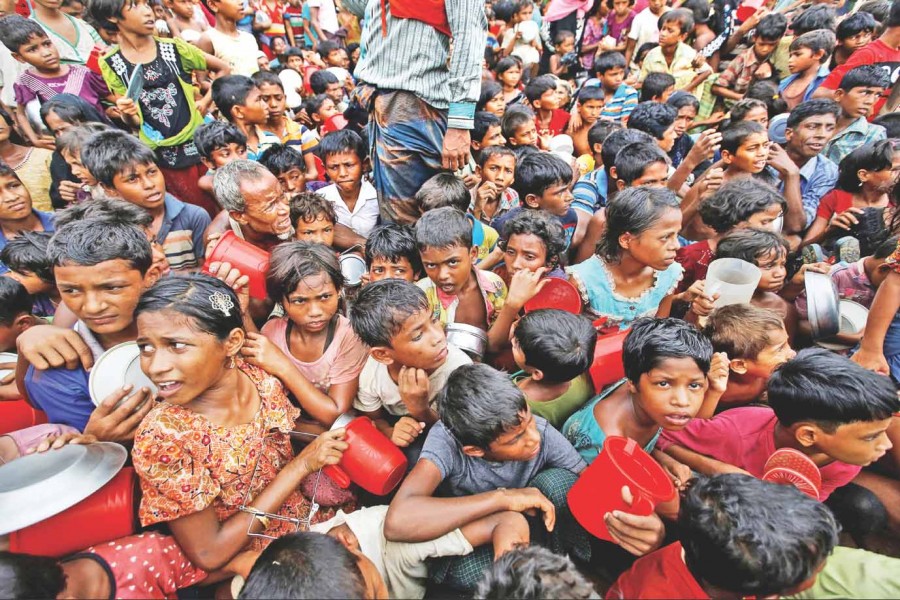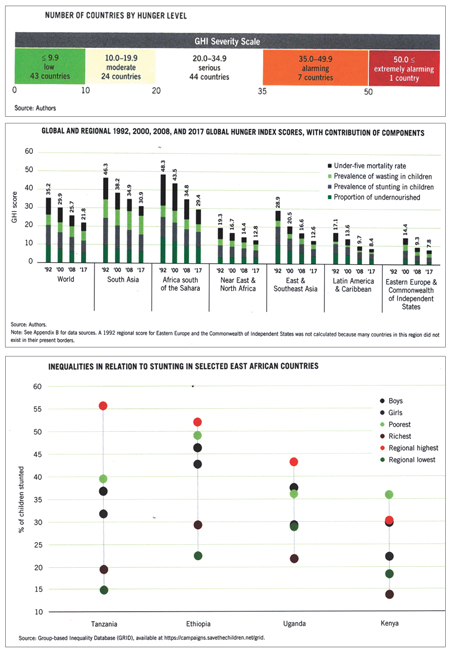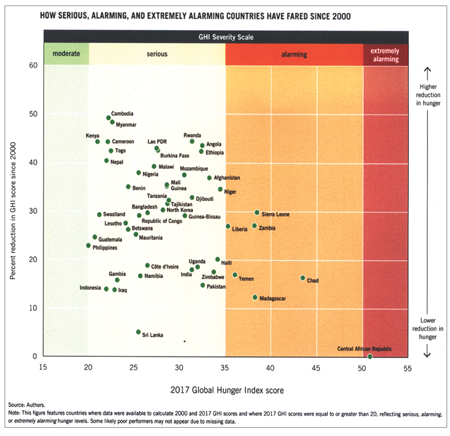 Rohingya refugee children wait to receive food outside the distribution centre at Palong Khali refugee camp near Cox's Bazar recently. — Reuters
Rohingya refugee children wait to receive food outside the distribution centre at Palong Khali refugee camp near Cox's Bazar recently. — Reuters  The global hunger index: This report's GHI scores are based on a formula that captures three dimensions of hunger -- insufficient caloric intake, child under-nutrition, and child mortality -- using four component indicators:
The global hunger index: This report's GHI scores are based on a formula that captures three dimensions of hunger -- insufficient caloric intake, child under-nutrition, and child mortality -- using four component indicators:
Undernourishment: the share of the population that is under-nourished, reflecting insufficient caloric intake;
Child wasting: the share of children under the age of five who are wasted (low weight-for-height), reflecting acute under-nutrition;
Child stunting: the share of children under the age of five who are stunted (low height-for-age), reflecting chronic under-nutrition; and
Child mortality: the mortality rate of children under the age of five.
Data on the indicators come from the Food and Agriculture Organisation of the United Nations (FAO), the World Health Organisation (WHO), UNICEF, the World Bank, Demographic and Health Surveys, the United Nations Inter-agency Group for Child Mortality Estimation (UN IGME), and International Food Policy Research Institute (IFPRI) estimates. The 2017 GHI is calculated for 119 countries for which data are available and reflects data from 2012 to 2016.
The GHI ranks countries on a 100-point scale, with 0 being the best score (no hunger) and 100 being the worst, although neither of these extremes is reached in actuality. Values less than 10.0 reflect low hunger; values from 10.0 to 19.0 reflect moderate hunger; values from 20.0 to 34.9 indicate serious hunger; values from 35.0 to 49.9 are alarming; and values of 50.0 or more are extremely alarming.
Rankings and trends: The number of hungry people in the world remains unacceptably high. Although the 2017 GHI shows long-term progress, millions are still experiencing chronic hunger and many places are suffering acute food crises and even famine.
The 2017 GHI overall score is 27 per cent lower than the 2000 score. Of the 119 countries assessed in this year's report, one falls in the extremely alarming range on the GHI Severity Scale; 7 are in the alarming range; 44 in the serious range; and 24 in the moderate range. Only 43 countries have scores considered low.
The regions of the world struggling most with hunger are South Asia and Africa south of the Sahara, with scores in the serious range (30.9 and 29.4, respectively). The scores of East and Southeast Asia, the Near East and North Africa, Latin America and the Caribbean, and Eastern Europe and the Commonwealth of Independent States range from low to moderate (between 7.8 and 12.8). These averages conceal some troubling results within each region, however, including scores in the serious range for Tajikistan, Guatemala, Haiti, and Iraq, and alarming in the case of Yemen, as well as scores in the serious range for half of all countries in East and Southeast Asia, whose average benefits from China's low score of 7.5.
A mixed picture: From the 2000 GHI to the 2017 GHI, the scores of 14 countries improved by 50 per cent or more; those of 72 countries dropped by between 25 and 49.9 per cent; and those of 27 countries fell by less than 25 per cent. Only the Central African Republic (CAR), the sole country in the extremely alarming range, showed no progress; its 2017 and 2000 GHI scores are the same.
Seven of the eight countries suffering from extremely alarming or alarming levels of hunger are in Africa south of the Sahara: CAR, Chad, Liberia, Madagascar, Sierra Leone, Sudan, and Zambia. The exception is Yemen, located at the tip of the Arabian Peninsula. Most of these countries have experienced political crises or violent conflicts in the past several decades. CAR and Yemen, in particular, have been riven by war in recent years.
Because data on the prevalence of under-nourishment and, in some cases, data or estimates on child stunting and child wasting were unavailable, 2017 GHI scores could not be calculated for 13 countries. Yet the countries with missing data may be the ones suffering most. Based on the available data and information from international organisations that specialise in hunger and under-nutrition, 9 of the 13 countries that lack sufficient data for calculating 2017 GHI scores still raise significant concern-Burundi, Comoros, Democratic Republic of Congo, Eritrea, Libya, Papua New Guinea, Somalia, South Sudan, and Syria.
Subnational scores: Differences in hunger and nutrition profiles within countries mean that a one-size-fits-all approach to tackling hunger and under-nutrition is unlikely to yield the best results. Sub-national-level data can be helpful in targeting programmes, as geographical targeting has been shown to be not only effective but also less expensive than household or individual targeting. Region-or state-level data, together with other information, can serve as a solid foundation for good programme and policy design.
An examination of sub-national-level data on stunting reveals wide disparities. Stunting levels vary widely within countries in all regions of the world. For example, Latin America has one of the lowest regional hunger levels, yet stunting levels in Guatemala's departments range from 25 per cent to a shocking 70 per cent. Furthermore, some countries with relatively low national stunting levels have states or regions with levels that are problematically high. In Gabon, where the national rate is only 16.5 per cent, the highest regional rate is 34.5 per cent. Similarly, certain countries with high national stunting levels include regions where the stunting rate is extreme, as in Afghanistan. Finally, some countries stand out as having sharper inequalities than comparable countries. For example, Nepal and Angola have similar national stunting levels and population sizes, and they are divided into roughly the same number of sub-national units for under-nutrition surveys. Yet the highest regional stunting rate in Nepal is 64 per cent compared to 51 per cent in Angola.
It is the people and groups with the least social, economic, or political power who suffer most from hunger or malnutrition. Thus any approach to tackling hunger should first examine how power works in the food system. Policies that fail to do so -- no matter how practical, technical, or scalable -- are unlikely to succeed.
How do inequalities of power lead to unequal nourishment? In food systems, power is exercised in a variety of ways and spaces, by a variety of actors: through concentrations of capital and market share that allow agrifood corporations to influence food prices and agricultural inputs; by government bodies, international organizations, or public-private partnerships that can influence, implement, or block food policies and shape debates; and even through individual decision making about household expenditures and family meals.
Interweaving inequalities: Inequality takes many forms -- as people can be disadvantaged due to gender, ethnicity, socioeconomic status, and other factors -- and understanding how it leads to or exacerbates hunger is not always straightforward. Gender inequality is one widely recognised axis of nutritional inequality. Many forms of chronic malnutrition are closely associated with low birth-weight and child and infant nutrition status, which are linked to women's lack of power in the household and society. Socioeconomic class and geography intersect with, and often surpass, gender as an axis of inequality. Yet another is ethnicity, illustrated by the poor nutrition outcomes -- low weight for-height (wasting), low height-for-age (stunting), and micronutrient deficiencies -- among indigenous peoples, who often face both poverty and socio-political marginalisation. Finally, people's access to changing food markets also shapes hunger and nutrition inequalities. In urban settings, marginalised people often find themselves stuck in "food deserts" or unable to afford healthy foods even when they are available.
 Understanding power: Power is exercised in a range of forms (from consumption to advertising to policy making), at various levels (global, national, and local), in multiple spaces (from farmers' unions to UN committees), offering myriad opportunities for campaigners, activists, practitioners, and policy makers to advocate, devise strategies, and build coalitions for change. Analyzing the role power plays in creating nutritional inequalities can help policy makers identify areas for action and possible allies as they formulate realistic nutrition policies and interventions.
Understanding power: Power is exercised in a range of forms (from consumption to advertising to policy making), at various levels (global, national, and local), in multiple spaces (from farmers' unions to UN committees), offering myriad opportunities for campaigners, activists, practitioners, and policy makers to advocate, devise strategies, and build coalitions for change. Analyzing the role power plays in creating nutritional inequalities can help policy makers identify areas for action and possible allies as they formulate realistic nutrition policies and interventions.
Leaving no one behind: Achieving the UN Sustainable Development Goals' aim of "leaving no one behind" demands approaches to hunger and malnutrition that are both more sensitive to their uneven distribution and more attuned to the power inequalities that intensify the effects of poverty and marginalization on malnutrition. To that end, power analysis can be used to name all forms of power that keep people hungry and malnourished; to design interventions strategically focused on where power is exerted; and to empower the hungry and malnourished to challenge and resist loss of control over the food they eat.
POLICY RECOMMENDATIONS
Although enough food is produced globally to feed the world, hunger persists -- largely the product of various and severe inequalities. Yet neither hunger nor inequality is inevitable; both are rooted in uneven power relations that often are perpetuated and exacerbated by laws, policies, attitudes, and practices. The following recommendations aim at redressing such power imbalances in order to alleviate hunger among the most vulnerable:
 Foster democratic governance of national food systems: To foster genuinely democratic governance of our food system, governments must actively include in the policy-making process underrepresented groups, such as small-scale farmers, that are involved in producing food and feeding people but often excluded from contributing to the policies and laws that affect their livelihoods.
Foster democratic governance of national food systems: To foster genuinely democratic governance of our food system, governments must actively include in the policy-making process underrepresented groups, such as small-scale farmers, that are involved in producing food and feeding people but often excluded from contributing to the policies and laws that affect their livelihoods.
Broaden participation in international food-policy debates: International bodies aiming to increase food and nutrition security must ensure the meaningful participation of people's movements and civil society organisations from all parts of the world to generate more productive debates around paradigms of food systems.
Guarantee rights and space for civil society: Governments must ensure space for civil society to play its role in holding decision makers to account on their obligation to protect and ensure the human right to adequate food. Integral to this is freedom of assembly and association, including peaceful protest, and the right to information.
Protect citizens and ensure standards in business and trade: Governments should create and enforce regulatory frameworks to safeguard citizens -- especially the most vulnerable -- from the negative impacts of international trade and agriculture agreements and the actions of private firms that could endanger citizens' food sovereignty and food and nutrition security. Private companies should act in compliance with internationally agreed human rights and environmental standards in their business activities, as described in the UN Guiding Principles on Business and Human Rights.
Analyze power to make better policies: National policies should take into account how hunger and malnutrition are distributed across the population, and how power inequalities affect different groups in society -- for example, how discriminatory gender norms and practices can harm the nutritional status of women and girls. Focusing on trade, land, agricultural, and other policies that have both visible and hidden impacts on food and nutrition security will help to align efforts in the fight against global hunger.
Increase support for small-scale food producers: Governments should build the capacity of small-scale producers, particularly women, by ensuring access to public services such as infrastructure, financial services, information, and training.
Advance equality through education and social safety nets: To reduce gross inequality and hunger, national governments must provide access to education and create social safety nets to ensure that all members of society -- including the most vulnerable and marginalized -- have income security and can access essential health care.
Hold governments accountable with timely data: To monitor progress toward Zero Hunger and hold governments accountable to their commitments, critical data gaps in relation to both hunger and inequality must be addressed, and national governments and international organisations must support the collection of disaggregated, independent, open, reliable, and timely data.
Invest in the SDGs and those left behind: Donors should adequately fund efforts to achieve the SDGs. This is particularly crucial for low-income countries, where official development assistance (ODA) is disproportionately necessary. Donors should meet internationally agreed targets by contributing 0.7 per cent of gross national income (GNI) to ODA as well as 0.15-0.2 per cent of GNI to the Least-Developed Countries.
© 2024 - All Rights with The Financial Express
